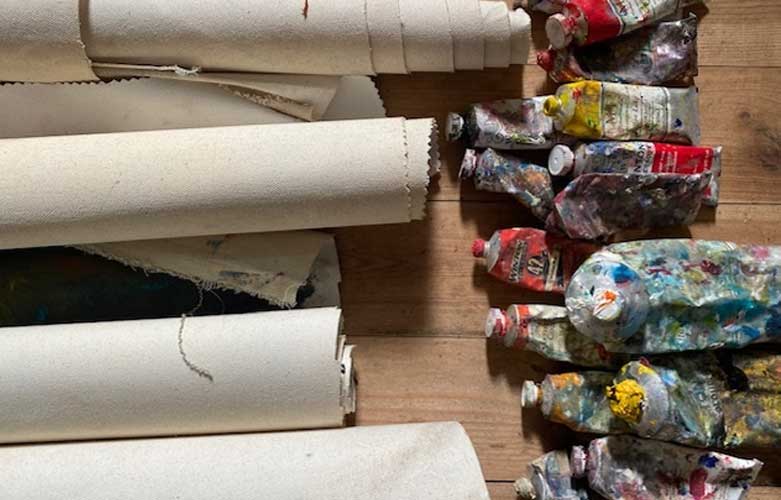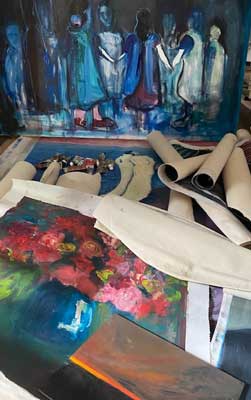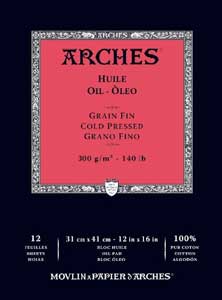
CANVASES – A QUICK AND DIRTY GUIDE
Welcome once again to Emily McCormack-Artist’s blog on all things Oil Painting.
Last week we looked at the Plein Air Easel and your kit to begin painting outdoors. This week, we are taking a quick look at the Painting Canvas. *
I paint both on canvas and boards. The boards I prepare myself and I’m still trialling and experimenting with various timbers and priming materials out there, so we will take a look at these in a future blog post.
CANVAS – THE INTRODUCTION
Canvas is just plain-woven fabric that has been used for sails, tents, backpacks and as supports for acrylic and oil painting.
The use of canvas can be dated back to Egyptian times, but it really took hold in Italy in the 16th century during the Renaissance. Especially in Venice, where it replaced the use of: –
- hardwood panels such as oak which was prone to absorbing moisture and warping; and
- the fresco that didn’t dry so well in the venetian lagoon.
Coupled with the invention of the power loom and developments in naval shipbuilding including sails, canvas became extremely popular.
It was much cheaper due to the large supply/mass production, it was relatively lightweight, easy to transport as it could be rolled up and also be supplied in long lengths which were made longer again when sewn together.
If you are interested in some further reading there is a great chapter in “Rembrandt – The Painter at Work” by Ernst Van De Wetering.
The Museo Del Prado also has a good article “The evolution of preparations for painting on canvas in sixteenth century Spain” by Pantoja de la Cruz, Juan.
CANVAS MATERIALS
There are two main types of canvas material:
- Cotton (Duck) – which became extremely popular in the 19th century and is the most commonly used canvas.
- Linen (Hemp) – is usually more expensive than cotton due to the number of processes it must undergo. It is stronger and less likely to tear, but it can be harder to stretch over your supports. Generally, it is the preferred choice of the professional artist as it doesn’t go as slack as cotton. Also, It can take the weight of paint much better.
Other canvas types include polycotton canvas which consists of mixed fibres and hessian canvas which was Francis Bacon’s go-to-canvas.
Canvas can be supplied in various weaves, known as extra fine, fine, medium or rough weave.
PRIMED OR UNPRIMED CANVAS – APPLYING THE LAYERS
Canvas can be supplied in its natural format known as unprimed or primed. Primed means that a “sizing” and “ground” or foundation layers have been applied as follows:
- Sizing a canvas is just applying a liquid to seal and stiffen the canvas and prevent it from rotting prematurely. Traditionally, hide glue was used such as rabbit skin glue. It’s quite easy to apply you just have to heat it in a bain-marie and then apply it with a paintbrush. PVA size is also another option instead of the bunny rabbit.
- Ground – is just 1 – 2no. layers of a foundation/ground layer after the sizing layer which one can then paint on. It can be gesso or acrylic-based.
Priming gives the canvas a smoother surface, allowing the brush to flow much better. If the canvas is poorly primed the oil paint may sink into the canvas, leaving dull patches on the surface of the painting. That being said, many artists choose to paint on unprimed canvas as it has a greater tooth, more absorbency and a rougher finish. So really, it’s a matter of preference.
Finally, if the canvas notes it’s “universal” that just means it can be used for both acrylic and/or oil painting.
TYPES OF CANVAS AVAILABLE
STRETCHED CANVAS
Stretched canvas is a canvas pre-stretched over a timber frame whose components are known as stretcher bars/supports. The stretched canvas can be purchased in various sizes, shapes (rectangular, square, and round) and depths known as thin/slim or deep edged/box canvas. They are handy in that all you have to do is take off the plastic wrapping and you are ready to rock and roll.
If you are a beginner and you are looking to practice your oil painting then Lidl sell a range of inexpensive canvases that are actually pretty good. They are generally well stretched. They don’t absorb the paint like some other canvases out there on the market, which is good when you are starting off. It can be soul-destroying when it’s as if the canvas is just eating your paint and you can’t seem to get enough on it. A lot of the students who attend the Painting Workshops over the years have brought in these canvases to paint on and there were never any issues with them. But if you do find you have a dent in your canvas and you want to remove it then see our TOP TIP in the previous blog post – “Easels – how to prop up that canvas – part 1”.
I really like painting on the Italian Belle Arti or the Linea canvas. But Artfix, Claessans, Evans own brand, Daler Rowney and Winsor and Newton are other well known brands.
CANVAS PADS/OIL PAINTING PAPER BLOCKS
Canvas pads/paper blocks are also very handy if you are starting off as a beginner.
Usually the pads contain 10 – 15no. sheets of either primed canvas or primed paper with a canvas texture for acrylic and/or oil painting. The weight and size of the canvas pads vary depending on the brand. Typical sizes range from 3 x 4 inches to 19 x 23 inches (or 50 x 60cm). The plus side is they are very handy for travelling abroad, practising painting, and doing oil sketches. The downside is they can tear and really if you are framing them it is a good idea to place them under glass.
Well-known brands include Jacksons (own brand), Fredrix, Arches, Belle Arti, Daler Rowney, Winton and Clairefontaine.
CANVAS ROLL
Canvas (linen, cotton or hessian) on the roll is just canvas supplied without supports. You can purchase it by the m2 or in half or full rolls. I usually buy a full roll which comes in 183cm or 210cm wide x 10m long. You can buy it unprimed, primed (black, clear or white) or universally primed and in various widths, textures and fibres. I find it very handy as I can just cut the canvas to suit the stretchers which I use from either an old canvas or you can buy the stretchers separately and make them up. Just allow about a 3inch surround around your canvas so that the framer has enough give to stretch it. In terms of storage, the canvas roll is great as I can have many paintings all stored in one roll.
Typical brands include Belli Arti, Claessans, Evans (own brand), Jacksons (own brand) and Artifix.
CANVAS BOARD
Canvas boards again come in various shapes and sizes but are inclined to warp a bit as you increase the size. They are inexpensive, lightweight, easy to frame and great for plein air painting as they are much more robust than the stretched canvas.
Typical brands include Elements, Winsor & Newton, Loxley, Clairfontain and Evans (own brand).
This is the last blog before the Easter Break. I will be back again Monday, two weeks-time looking at How to Lay out that Palette.
Happy Easter to you all.
Emily McCormack
March 2021
* As always, I am not affiliated with any brands, stores, or persons I may or may not mention and your use of any of these products, links and the like are your own risk and its up to you to do your research/homework before you use them. This is just my opinion and experience.

Become an insider, subscribe to receive
Stunning previews of new art, discounts, painting tips and early booking for painting workshops.




